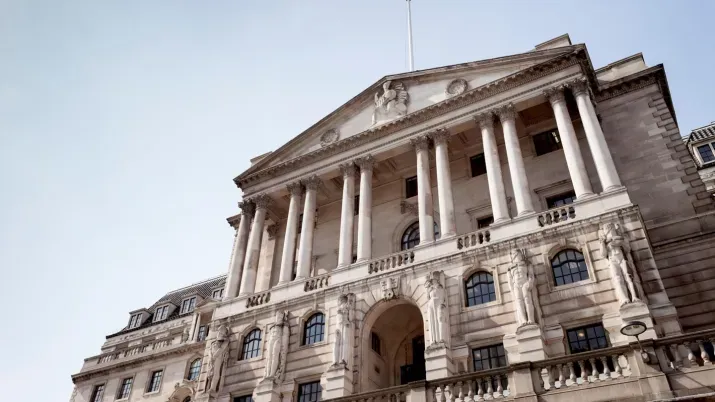BoE: A historic vote and a hawkish cut
The Bank of England (BoE) delivered a widely expected 25bp cut on Thursday, taking interest rates to a two-year low of 4%. But the real story was in the balance of views on the Monetary Policy Committee (MPC), which for the first time in its 28-year history had to conduct two rounds of voting and has forced markets to reassess the path of future rate cuts.
The first MPC vote failed to produce a majority, with four of the nine members in favour of holding, four backing a 25bp cut and one, Alan Taylor, calling for a more aggressive 50bp reduction. With no majority, Governor Andrew Bailey called a decisive second vote, in which Taylor backed the 25bp option to bring about a 5-4 majority. While the outcome ultimately aligned with market expectations, the surprisingly tight vote was read as hawkish and sparked a sell-off in gilts.
The BoE’s commentary also leaned to the hawkish side, with its statement noting that “upside risks around medium-term inflationary pressures have moved slightly higher” and that “the restrictiveness of monetary policy has fallen.” This appears to be a shift in focus from the BoE; previously, a loosening labour market was a dominant factor driving cuts, but now there is a clear focus on heightened inflation and whether second-round effects take hold, noting policy restrictiveness is reduced. In effect, this was a hawkish cut, with the bar for further easing tied to progress on disinflation. Unsurprisingly, the BoE did not commit to a specific path for future rate cuts and reiterated its data-dependent approach.
UK headline CPI inflation rose to 3.6% in June, 0.2% higher than the Bank expected. The BoE now expects inflation to peak at 4.0% in September, declining to 3.6% by year-end, before falling to 2.7% in Q3 2026 and gradually returning to its 2% target by mid-2027. A significant portion of the recent pick-up was driven by energy and food, with Bailey attributing roughly half the pressures to global factors (such as energy and commodities) and half to domestic issues (utility price rises and the increase in national insurance and the national living wage). Food price inflation was 4.5% in June, and is expected to rise to 5.5% by year-end, a factor which along with utility bills disproportionately affects low-income households and could drive an increase in household inflation expectations, a key worry for the BoE. Meanwhile, services inflation remains stubborn at 4.7%, reflecting still-elevated wage growth and policy-related cost increases.
The BoE also highlighted ongoing signs of labour market loosening, with unemployment rising to 4.7%, vacancies falling, and utilisation surveys pointing to spare capacity. Unemployment is expected to peak at just below 5% in mid-2026. Private sector regular pay growth slowed to 4.9% in the three months to May, down from 5.9% earlier in the year and below the BoE’s May projection of 5.4%. It is expected to decline further to 3.7% by the end of 2025. While the MPC remains divided on how much slack has truly emerged, the BoE’s broader wage indicators reinforce a disinflationary trend. Within its settlements database, the share of pay awards above 5.25% has dropped from over 50% to below 20% over the past year, while awards in the 2.5-3.75% range have risen from just 6% to 36%. This normalisation in pay distribution supports the view that wage pressures are easing, even if they are not yet fully aligned with the inflation target.
Markets initially saw this August rate cut as a done deal. But the vote split, cautious tone, and stronger inflation forecasts have forced a rethink of rate cut expectations. Prior to the meeting markets had fully priced in a 25bp cut at the December meeting and another 25bp cut in June 2026. Immediately post-decision markets pushed back the timing, with the chance of a December cut falling to 75% with the first full cut delayed to February and the second to July. Two further cuts would take interest rates to 3.5%, which is where markets are projecting they will bottom out for this cycle. The gilt curve “bear flattened” on the day with two-year yields 5.6bp higher, 10-year yields 2bp higher and 30-year yields unchanged. Given the hawkish messaging, market reaction was actually fairly muted with rate cut expectations being delayed rather than priced out.
Thursday’s meeting paints a picture of an MPC that remains cautious, recognising both upside and downside risks to inflation. While the path for rates remains downward, the BoE is no longer prioritising labour market slack and is instead focused on sticky inflation and second-round risks of higher inflation becoming entrenched. The vote split, combined with explicit concerns about inflation persistence, suggest the BoE is closer to a pause than markets had assumed just weeks ago. These dynamics are not dissimilar to those in the US, where concerns about a softening labour market point to the need for rate cuts, but persistent inflation and the upside risks from tariffs continues to justify a restrictive policy stance.
The message was clear: the path ahead is uncertain, the BoE is in no rush to cut further, and any easing will depend on clear progress in bringing inflation down. With rate cuts delayed, the current yield environment continues to offer compelling value for bond investors in our view. While credit spreads are tight, elevated government bond yields mean all-in yields remain attractive. As we noted at the start of the year, carry remains the key driver of returns.




